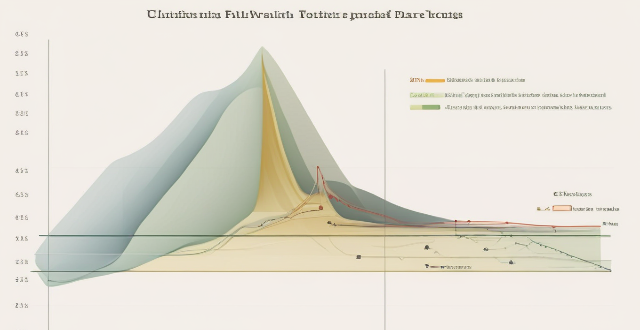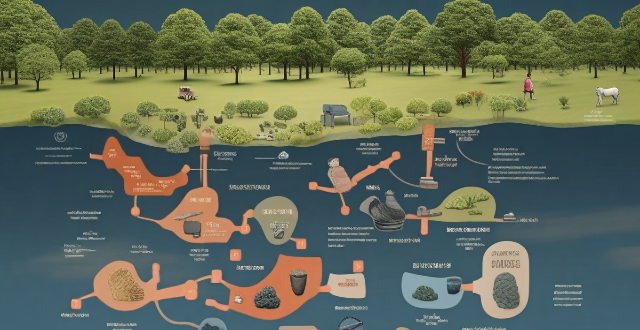Health Measure

Which economic indicators are used to measure the health of the labor market ?
The health of the labor market is crucial for any economy, and several economic indicators are used to measure it. These include the unemployment rate, employment growth, labor force participation rate, wage growth, and job openings and vacancies. The unemployment rate measures the percentage of the labor force that is unemployed but actively seeking work, while employment growth refers to the number of new jobs created over a specific period. The labor force participation rate measures the percentage of working-age individuals who are either employed or actively seeking employment, and wage growth reflects the earning power of workers. Job openings and vacancies provide insight into the demand for labor within the economy. By monitoring these indicators regularly, stakeholders can identify trends and potential issues early on, allowing them to take proactive steps to address any challenges and promote a healthy labor market.

What is social distancing and why is it important during a pandemic ?
Social distancing is a crucial measure in pandemic control. It involves maintaining physical distance between people to reduce the spread of infectious diseases. The importance of social distancing during a pandemic includes reducing transmission rates, protecting vulnerable populations, allowing health systems to cope, and facilitating other public health measures. To effectively implement social distancing, governments and health organizations often recommend or mandate measures such as stay at home orders, remote work, closure of non-essential businesses, cancellation of events, and public awareness campaigns. Adhering to social distancing guidelines becomes a community effort towards a safer and healthier environment for all.

How can we measure climate vulnerability ?
Measuring climate vulnerability involves identifying relevant indicators, collecting data and information, analyzing vulnerability levels, prioritizing adaptation measures, and monitoring progress. This process helps identify areas most at risk from climate change impacts and develop strategies to reduce their vulnerability.

How do women-specific NGOs measure their impact on reducing poverty and inequality ?
This article explores how women-specific NGOs measure their impact on reducing poverty and inequality by focusing on key metrics such as economic empowerment, education and skill development, health and well-being, and gender equality and empowerment. It also highlights successful NGOs like Women's World Banking, Room to Read, and International Planned Parenthood Federation (IPPF) that use data collection tools to track progress towards their goals.

What is the GDP and why is it considered a crucial economic indicator ?
GDP is a crucial economic indicator that measures the market value of all final goods and services produced by a country in a specific time period. It serves as a measure of economic activity, national wealth, and a benchmark for international comparisons. GDP also impacts financial markets, reflects the standard of living, influences global perceptions, and drives employment opportunities. However, it should be considered in conjunction with other indicators for a more holistic understanding of an economy's health.

What is the relationship between sports participation and improved mental health from a public policy perspective ?
The relationship between sports participation and improved mental health is complex and multifaceted, involving considerations of individual well-being, societal benefits, economic implications, and governmental responsibilities. Regular exercise through sports can lead to better physical health, which positively impacts mental health by releasing endorphins and reducing stress. Social interaction promoted by team sports and community building through sports events enhances social support networks crucial for mental health. From a societal perspective, promoting sports participation can serve as a preventive measure against mental health disorders, potentially reducing healthcare costs and improving educational outcomes. Economically, a healthier workforce and tourism opportunities from sports events can boost productivity and local economies. Governments have responsibilities in funding sports facilities, integrating sports into education, and running public awareness campaigns. Overall, fostering sports participation through supportive policies can significantly improve public mental health while offering broader societal and economic advantages.

How do fitness trackers measure calories burned ?
**How Fitness Trackers Measure Calories Burned: A Comprehensive Overview** Fitness trackers have revolutionized the way we monitor our physical activities and health. One of their most popular features is the ability to estimate the number of calories burned during various exercises. But how do these devices actually calculate this information? In this article, we delve into the science behind fitness trackers and explore the key components that contribute to their calorie-burning estimates. Firstly, heart rate monitoring plays a crucial role. By tracking your heart rate, fitness trackers can gauge the intensity of your workout and, therefore, the approximate number of calories you're burning. Secondly, activity recognition allows the device to identify specific types of movement, such as walking or running, and apply corresponding metabolic equivalent (MET) values to calculate energy expenditure. Thirdly, personal information like age, gender, height, weight, and daily activity level are essential for customizing calorie burn calculations to your unique profile. Finally, sophisticated algorithms combine all these data points to provide an estimate of calories burned. However, it's important to remember that these estimates are not exact measurements but rather approximations based on scientific research and technological advancements. As such, fitness trackers should be viewed as valuable tools to aid in your fitness journey rather than definitive indicators of progress.

How can we measure the effectiveness of climate resilience strategies ?
Measuring the effectiveness of climate resilience strategies is crucial for ensuring that communities and ecosystems are adequately prepared for the impacts of climate change. Key factors to consider when evaluating the success of these strategies include assessing impact reduction, monitoring adaptive capacity, evaluating systemic resilience, long-term sustainability, scalability and replication, and community engagement and perception. By considering these factors and using a combination of quantitative data analysis and qualitative assessments, we can comprehensively measure the effectiveness of climate resilience strategies. This will help in refining current approaches and informing future strategies to build a more resilient world in the face of ongoing climate change.

How can we measure the extent of climate loss and damage ?
Measuring the extent of climate loss and damage requires a comprehensive approach that considers various factors, including direct and indirect impacts on natural and human systems. To measure these impacts, we need to identify affected areas, quantify economic losses, assess social and health impacts, evaluate environmental impacts, and consider long-term implications. By doing so, we can better understand the scope of climate loss and damage and develop effective strategies for adaptation and mitigation.

Is there a way to measure network latency ?
Measuring network latency is crucial for understanding a network's performance. The ping test, traceroute, and online tools are methods to measure latency. Ping tests estimate the round-trip time, while traceroute identifies bottlenecks in the network path. Online tools provide visual representations of network performance.

What is the concept of green GDP, and how can it help measure economic progress while considering environmental factors ?
The text discusses the concept of Green GDP, which is an alternative measure of economic performance that adjusts the traditional Gross Domestic Product (GDP) by subtracting the costs of environmental degradation and resource depletion. It aims to provide a more accurate picture of a country's economic health, one that reflects the long-term sustainability of its growth. The inclusion of environmental costs in Green GDP helps promote sustainable development, encourages policy planning, and raises public awareness about the true cost of economic activities. However, calculating green GDP faces challenges such as complex methodologies, limited data availability, and political will. Despite these challenges, Green GDP offers a valuable tool for promoting sustainable development and fostering a more balanced relationship between economic growth and environmental protection.

How do I measure progress in my sports training plan ?
Measuring progress is crucial for athletes to track development and adjust their training plans. Set SMART goals, track performance, evaluate technique, monitor body composition, assess fitness level, and reflect on mental state to measure progress effectively.

How do professional bartenders measure ingredients for consistency ?
Professional bartenders use a variety of tools and techniques to measure ingredients consistently. Accuracy is crucial for maintaining the same flavor profile and balancing different tastes in cocktails. Efficiency is also important, as it speeds up drink-making and allows bartenders to focus on customer interaction. Jiggers are commonly used tools for measuring both large and small quantities of liquids. Measuring spoons are used for smaller amounts like bitters or syrup. Digital scales are used for precise measurements by weight, especially for ingredients like fruit juices or syrups. Pour spouts and containers help control the flow of liquids to reduce spillage and waste. Standardization processes such as recipe cards, batching, and taste testing are also essential. Recipe cards include detailed measurements for each ingredient, helping new bartenders learn quickly and maintain consistency. Batching involves pre-mixing a large volume of a single cocktail ingredient or an entire recipe, saving time during busy shifts and ensuring uniformity. Taste tests are crucial even with precise measurements, as bartenders adjust recipes based on customer feedback and ingredient freshness. In conclusion, professional bartenders rely on a combination of tools, techniques, and standardized processes to measure ingredients consistently. This ensures that they can replicate the perfect cocktail every time, providing a high-quality experience for their customers.

How can we measure the effectiveness of community climate adaptation efforts ?
Measuring the effectiveness of community climate adaptation efforts is crucial for understanding their impact on resilience to climate change. Key steps include setting clear objectives, developing relevant indicators, collecting and analyzing data, transparent reporting, evaluating success, iterative improvement, community engagement, and policy alignment. By following these steps, communities can ensure their adaptation efforts are effective and continuously improved.

How can we measure the value of ecosystem services ?
The article discusses various methods to measure the value of ecosystem services, which are benefits humans derive from ecosystems. These include provisioning, regulating, cultural, and supporting services. Measuring their value is crucial for informed decisions about management and conservation. Methods include direct market valuation, indirect market valuation, revealed preference methods, avoided cost method, replacement cost method, and benefit transfer method. By using these techniques, policymakers and managers can make informed decisions about resource allocation for ecosystem conservation and restoration.

What are the different types of sensors used in environmental monitoring ?
Environmental monitoring involves the use of various sensors to collect data on different environmental parameters. These sensors include temperature sensors, humidity sensors, pressure sensors, light sensors, and chemical sensors. Temperature sensors measure the temperature of the environment and are crucial for monitoring weather patterns, climate change, and the impact of human activities on the environment. Humidity sensors measure the moisture content in the air and are essential for monitoring weather patterns, air quality, and the impact of human activities on the environment. Pressure sensors measure the force per unit area exerted by a fluid or gas and are crucial for monitoring weather patterns, air quality, and the impact of human activities on the environment. Light sensors measure the intensity and wavelength of light in the environment and are essential for monitoring solar radiation, atmospheric conditions, and the impact of human activities on the environment. Chemical sensors measure the presence and concentration of specific chemicals in the environment and are crucial for monitoring air and water quality, soil contamination, and the impact of human activities on the environment. Overall, these sensors help us understand the state of our environment and take necessary actions to protect it.

How do investors measure the ESG impact of their portfolios ?
Investors measure the ESG impact of their portfolios by considering environmental, social, and governance factors. They use methods such as ESG ratings, weighted scores, thematic analysis, scenario analysis, and active ownership to evaluate the alignment of their investments with their values and goals.

How can you measure the effectiveness of a personal safety training program ?
Personal safety training programs are crucial for individuals to learn how to protect themselves from potential threats and hazards. However, it is equally important to measure the effectiveness of these programs to ensure that they are achieving their intended goals. Here are some ways to measure the effectiveness of a personal safety training program: 1. Assessment Tests: Before and after the training program, conduct assessment tests to gauge participants' knowledge and skills related to personal safety. These tests can include quizzes, case studies, or role-playing scenarios. Compare the results of the pre-test and post-test to determine if there has been an improvement in participants' understanding and application of safety concepts. 2. Observations: During the training sessions, observe participants' engagement levels, participation, and interactions with each other. Look for signs of active learning, such as asking questions, sharing experiences, and offering suggestions. High levels of engagement and participation indicate that the program is effective in delivering its content. 3. Feedback Surveys: After completing the training program, collect feedback from participants through surveys or evaluation forms. Ask them about their overall satisfaction with the program, what they learned, and how they plan to apply it in their daily lives. Analyze the responses to identify areas where the program was successful and areas that may need improvement. 4. Follow-Up Sessions: Schedule follow-up sessions several weeks or months after the initial training to review key concepts and reinforce learning. This will help participants retain the information and apply it when necessary. During these sessions, assess participants' recall and understanding of the material covered in the original training program. 5. Incident Reports: Track incident reports related to personal safety before and after the training program. A decrease in the number of incidents or severity of incidents could be an indication that the program is effective in reducing risks and promoting safer behaviors among participants. By implementing these methods, you can measure the effectiveness of your personal safety training program and make necessary adjustments to ensure that it continues to meet the needs of your participants.

What measures are being taken to control the spread of virus variants ?
The emergence of virus variants is a significant concern globally. Various measures are being implemented to control their spread, including surveillance and genomic sequencing, testing and tracing, border controls and travel restrictions, vaccination efforts, public health measures, research and development, and education and messaging. These strategies aim to mitigate the impact of variants and protect populations from more severe outbreaks. It is crucial for everyone to stay informed and continue following public health guidelines to contribute to these efforts.

What are the health and safety considerations for organizing a food festival ?
Organizing a food festival requires careful consideration of health and safety measures to protect vendors and attendees. Key areas include sanitation and hygiene, allergy information and labeling, food safety inspections, first aid and emergency response, crowd management, fire safety, and cleanliness and waste management. By implementing these measures, you can ensure a safe and enjoyable event for all.

How does vaccine distribution affect public health ?
Vaccine distribution is crucial for global health, reducing disease incidence and healthcare costs while increasing productivity. Challenges include inequitable access, logistical complexities, and public perception issues.

How do countries measure their progress towards achieving climate goals ?
Countries measure their progress towards achieving climate goals through various indicators and metrics. These include Nationally Determined Contributions (NDCs), greenhouse gas inventories, renewable energy production, carbon intensity, forest cover and land use changes, climate finance flows, policy implementation, and public awareness and participation. By tracking these factors, countries can assess their performance in reducing emissions, adapting to climate impacts, and supporting global efforts to combat climate change.

How can companies measure the effectiveness of celebrity endorsements on sales ?
Measuring the effectiveness of celebrity endorsements on sales is crucial for companies to determine the return on investment (ROI) of their marketing campaigns. Companies can measure the impact of celebrity endorsements on sales by analyzing sales data, brand awareness and equity metrics, customer acquisition and retention rates, and social media engagement and sentiment analysis. These methods provide insights into changes in sales volume, revenue, market share, consumer perceptions of the brand, customer demographics, purchase behavior, loyalty, and overall impact on consumer attitudes and potential sales. By using these methods, companies can gain valuable insights into the ROI of their celebrity endorsement campaigns and make informed decisions about future marketing strategies.

How to measure the effectiveness of influencer marketing ?
Influencer marketing is a popular strategy for brands to reach target audiences, but measuring its effectiveness can be difficult. Key metrics include engagement rates (likes, comments, shares), follower growth, website traffic, conversion rates, ROI, brand awareness & sentiment, and influencer performance metrics (reach, impressions, CTR). By tracking these metrics and analyzing them regularly, brands can gain insights into the success of their campaigns and make data-driven decisions for future collaborations.

How does a balanced diet impact women's bone health ?
Balanced diet is crucial for women's bone health, including preventing osteoporosis. Key nutrients are calcium, vitamin D, protein, and phosphorus. Fruits and vegetables also support overall well-being.

How can businesses measure and report their environmental performance throughout their supply chains ?
Measuring and reporting environmental performance in supply chains involves setting clear objectives, conducting a baseline assessment, developing an action plan, implementing and monitoring progress, and reporting performance transparently. Adopting standardized metrics, engaging stakeholders, and continuously improving are best practices to effectively manage environmental impact throughout the supply chain.

What is the role of the World Health Organization (WHO) in promoting global health ?
The World Health Organization (WHO) plays a crucialThe World Health Organization (WHO) plays a crucial by providing leadership, setting norm WHO's work is focused on improving health outcomes worldwide through various activities such as convening stakeholders, establishing international standards for health, generating scientific knowledge to inform policy decisions, providing technical support to countries, and monitoring global health trends.

How can countries improve their preparedness for global health emergencies ?
Countries can improve their preparedness for global health emergencies by strengthening healthcare infrastructure, developing surveillance and early warning systems, enhancing international cooperation, improving public health education and awareness, and establishing contingency plans and policies.

What are the long-term health consequences of climate change ?
The long-term health consequences of climate change are multifaceted and can be categorized into several key areas, including increased frequency and severity of heat waves, extreme weather events, spread of diseases, air quality issues, food insecurity, and mental health impacts. These effects have far-reaching implications for public health and require urgent action to mitigate their impact.

How can I measure the ROI of my social media marketing efforts ?
Measuring the return on investment (ROI) of your social media marketing efforts is crucial for understanding the effectiveness of your campaigns and making data-driven decisions. Here's a step-by-step guide to help you measure the ROI of your social media marketing efforts: 1. Set clear goals for your social media marketing campaigns. These goals should be specific, measurable, achievable, relevant, and time-bound (SMART). Some common goals include increasing brand awareness, generating leads, driving website traffic, and boosting sales. 2. Identify the key performance indicators (KPIs) that will help you measure your progress towards achieving those goals. Some common KPIs for social media marketing include engagement rate, reach, click-through rate, and conversion rate. 3. Use analytics tools to track your KPIs and monitor your campaign's performance. Most social media platforms offer built-in analytics tools, and there are also third-party tools like Google Analytics, Hootsuite, and Sprout Social that provide more detailed insights into your social media marketing efforts. 4. Calculate your ROI by comparing the revenue generated by your social media marketing campaigns to the costs associated with those campaigns. Use the formula: ROI = (Revenue - Cost) / Cost x 100%. For example, if your social media marketing campaign generates $5000 in revenue and costs $2000 to run, your ROI would be 150%. This means that for every dollar spent on your social media marketing campaign, you earned $1.50 in return. 5. Analyze and optimize your results to identify areas for improvement and optimize your future campaigns accordingly. If your ROI is lower than expected, consider adjusting your targeting, messaging, or ad spend to improve your results. Remember that measuring the ROI of your social media marketing efforts is an ongoing process. Continuously track your KPIs, analyze your results, and make data-driven decisions to maximize the effectiveness of your campaigns.